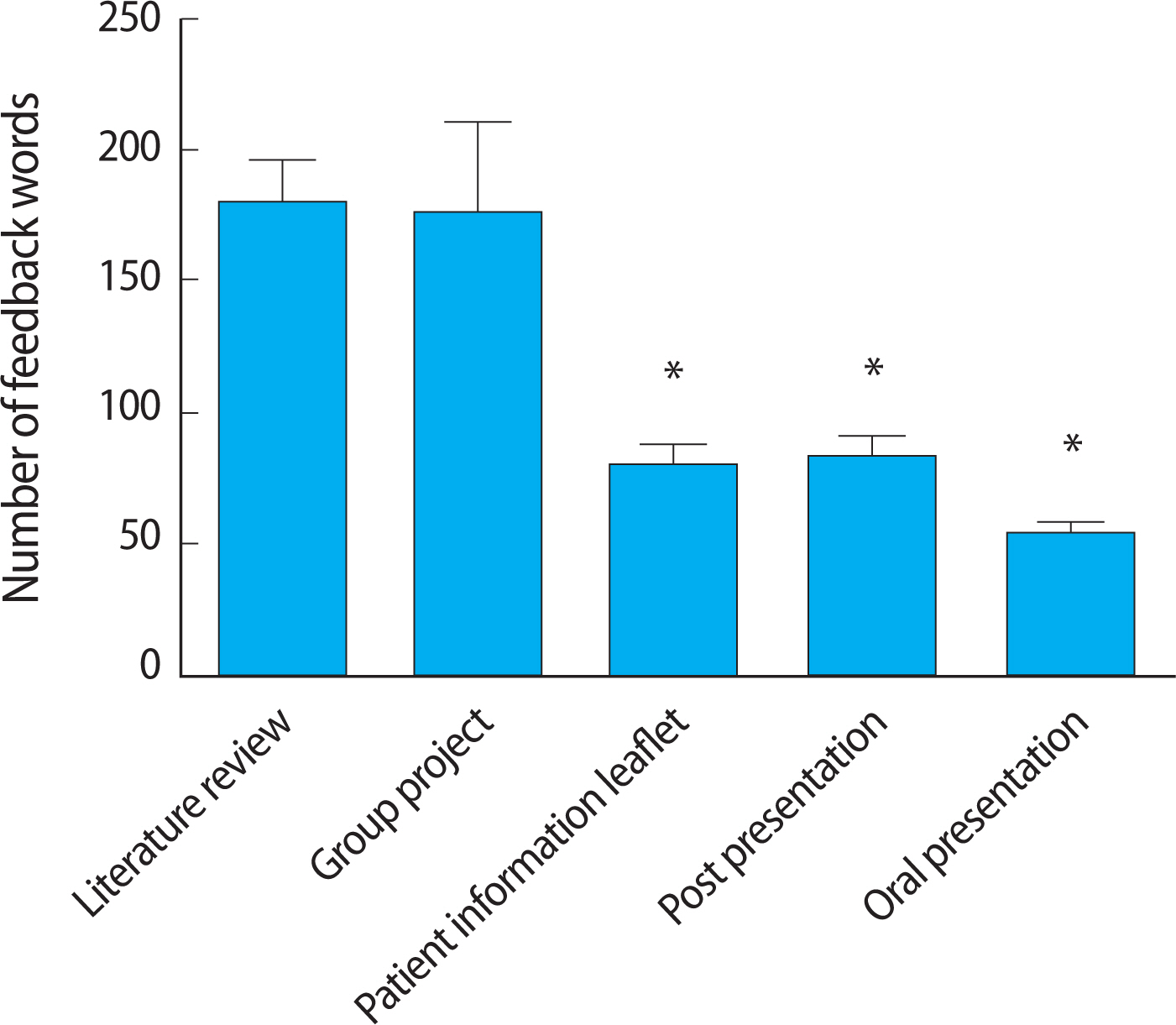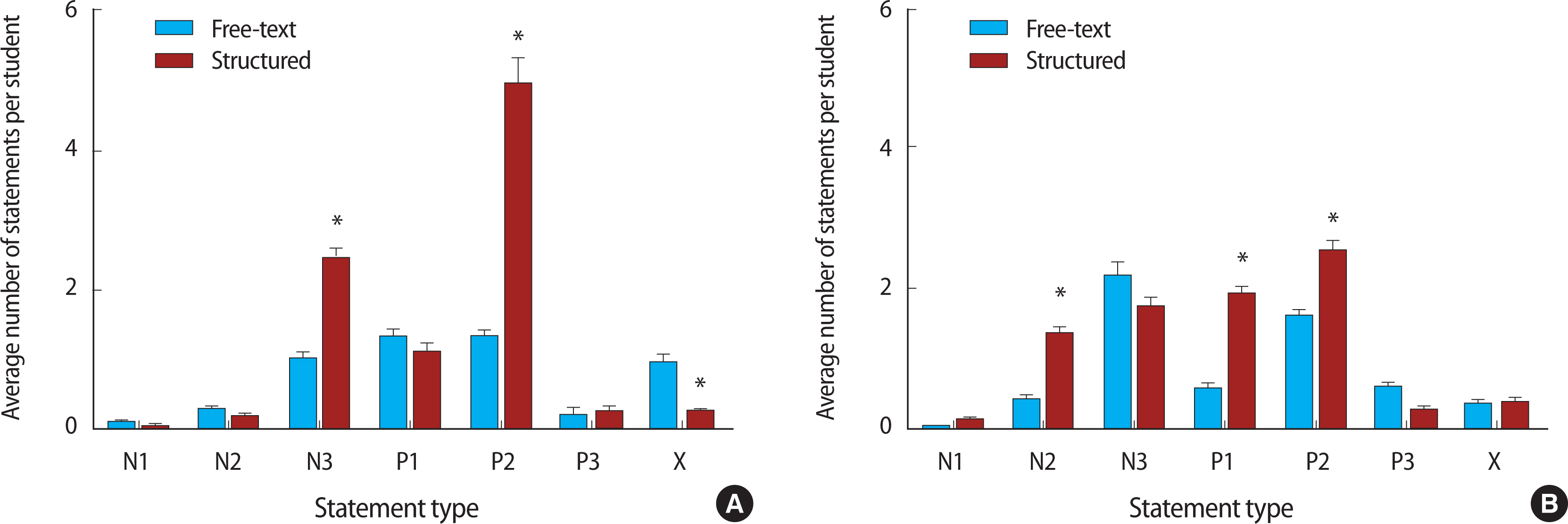J Educ Eval Health Prof.
2012;9:10.
Improved quality and quantity of written feedback is associated with a structured feedback proforma
- Affiliations
-
- 1Graduate Entry Medicine Programme, College of Medicine, Swansea University, Swansea, UK. p.newton@swansea.ac.uk
- 2Institute of Experimental and Molecular Medicine, School of Medicine, Cardiff University, Cardiff, UK.
Abstract
- Facilitating the provision of detailed, deep and useful feedback is an important design feature of any educational programme. Here we evaluate feedback provided to medical students completing short transferable skills projects. Feedback quantity and depth were evaluated before and after a simple intervention to change the structure of the feedback-provision form from a blank free-text feedback form to a structured proforma that asked a pair of short questions for each of the six domains being assessed. Each pair of questions consisted of asking the marker 'what was done well?' and 'what changes would improve the assignment?' Changing the form was associated with a significant increase in the quantity of the feedback and in the amount and quality of feedback provided to students. We also observed that, for these double-marked projects, the marker designated as 'marker 1' consistently wrote more feedback than the marker designated 'marker 2'.
Keyword
MeSH Terms
Figure
Reference
-
1. Shute VJ. Focus on formative feedback. Rev Educ Res. 2008; 78:153–89.
Article2. Boehler ML, Rogers DA, Schwind CJ, Mayforth R, Quin J, Williams RG, Dunnington G. An investigation of medical student reactions to feedback: a randomized controlled trial. Med Educ. 2006; 40:746–9.3. Nicol DJ, Macfarlane-Dick D. Formative assessment and self-regulated learning: a model and seven principles of good feedback practice. Stud High Educ. 2006; 31:199–218.
Article4. Nicol D. From monologue to dialogue: improving written feedback processes in mass higher education. Assess Eval High Educ. 2010; 35:501–17.
Article5. Higher Education Funding Council for England. National Student Survey findings and trends 2006 to 2009 [Internet]. Bristol: Higher Education Funding Council for England;2010. [cited 2012 Jul 20]. Available from: http://www.hefce.ac.uk/pubs/hefce/2010/10_18/.6. Lunt T, Curran J. ‘Are you listening please?’ The advantages of electronic audio feedback compared to written feedback. Assess Eval High Educ. 2010; 35:759–69.
Article7. Merry S, Orsmond P. Students’ attitudes to and usage of academic feedback provided via audio files. Biosci Educ. 2008. 11:3. http://dx.doi.org/10.3108/beej.11.3.
Article8. Bailey RA. Undergraduate students’ perceptions the role and utility of written assessment feedback [Internet]. J Learn Dev High Educ. 2009. 1:Available from: http://www.aldinhe.ac.uk/ojs/index.php?journal=jldhe&page=article&op=view&path%5B%5D=29.9. Mutch A. Exploring the practice of feedback to students. Activ Learn High Educ. 2003; 4:24–38.
Article10. General Medical Council. Tomorrow’s doctors online (2009) [Internet]. London: General Medical Council;2012. [cited 2012 Jul 20]. Available from: http://www.gmc-uk.org/education/undergraduate/tomorrows_doctors_2009.asp.11. Glover C, Brown E. Written feedback for students: too much, too detailed or too incomprehensible to be effective? Biosci Educ. 2006. 7:3. Available from: http://www.bioscience.heacademy.ac.uk/journal/vol7/beej-7-3.aspx.
Article12. Brown E, Gibbs G, Glover C. Evaluating tools for investigating the impact of assessment regimes on student learning. Biosci Educ. 2003. 2:5. Available from: http://www.bioscience.heacademy.ac.uk/journal/vol2/beej-2-5.aspx.13. Bryan C, Clegg K, editors. Innovative assessment in higher education. London: Psychology Press;2006.14. Walker M. Feedback, assessment and skills development. Rust C, editor. Improving student learning: for what? Oxford: The Oxford Centre for Staff and Learning Development;2008. p. 228–40.15. Irons A. Enhancing learning through formative assessment and feedback. New York: Routledge;2007.16. Langer P. The use of feedback in education: a complex instructional strategy. Psychol Rep. 2011; 109:775–84.
Article17. Lea MR, Street BV. Student writing in higher education: an academic literacies approach. Stud High Educ. 1998; 23:157–72.
Article
- Full Text Links
- Actions
-
Cited
- CITED
-
- Close
- Share
- Similar articles
-
- Application of Feedback Education to the Progression Notes Written by Medical Students in Surgical Clerkship
- The integrative feedback tool: assessing a novel feedback tool among emergency medicine residents
- What kind of feedback do medical students want?
- Effects of Examiner's Verbal Feedback on Nursing Students' Accuracy of Self-assessment, Emotional Response, Self-efficacy, and Perceived Quality of Feedback in Skill Performance Assessment
- Nursing Students' Peer Feedback Types and Emotional Response, Quality of Feedback, and Self-efficacy for Learning from Peer Feedback in Skill Training






